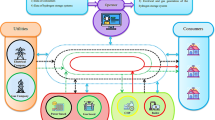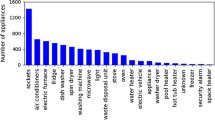Abstract
At the distribution level, the traditional approach of pricing for voltage control ancillary service shows certain disadvantages as it considers only production costs. For the optimized procurement and pricing of active power and reactive power provision from reactive power compensating devices (RPCDs) such as APFCs, D-STATCOM and converter-controlled distributed generators (CCDGs), its location, availability, as well as its capability, are of utmost importance. For better pricing signals, the pricing structure for active power and reactive power compensation service needs to consider all major cost components like depreciation cost, cost of losses, capital cost, and balance of system cost. In this work, an attempt has been made to address the procurement and pricing issues at distribution level, by proposing optimized active power and reactive power management (OARPM) and developing ‘Extended Nodal Pricing Function' (‘ENPF’) for its pricing. This is specially developed for pricing the optimized active power and reactive power provision cost through RPCDs and CCDGs installed in grid-connected microgrid at distribution level achieving system performance improvement and bring economic savings. To test the impact of proposed OARPM and ENPF, five different cases are analyzed using Indian real-time distribution system data. The impact of proposed methodology is observed on 5 aspects of system performance that are dispatch of active power and reactive power, power losses minimization, objective function cost minimization, active power and reactive power DLMP and voltage control. The methodology is generic to implemented for pricing in any electricity market.
















Similar content being viewed by others
Data Availability
All data generated or analyzed during this study are included in this published article.
References
Abinaya K, Danalakshmi D, Kannan S (2014) Cost analysis of reactive power using marginal cost theory in electricity markets. In: International conference on circuit, power and computing technologies 20–21 March, Nagercoil, India. https://doi.org/10.1109/ICCPCT.2014.7055055
Alsokhiry F, Adam GP, Lo KL (2012) Contribution of distributed generation to ancillary services. In: 47th international Universities power engineering conference (UPEC), 4–7 Sept, London, UK. https://doi.org/10.1109/UPEC.2012.6398451
Ameri AA, Ounissa A, Nichita C, Djamal A (2017) Power loss analysis for wind power grid integration based on weibull distribution. Energies 10(4):1–16. https://doi.org/10.3390/en10040463
Bai L, Wang J, Wang C, Li CF (2017) Distribution locational marginal pricing for congestion management and voltage support. IEEE Trans Power Syst 33(4):4061–4073. https://doi.org/10.1109/TPWRS.2017.2767632
Barquin Gil J, San Roman TG, Alba Rios JJ, Martin PS (2000) Reactive power pricing a conceptual framework for remuneration and charging procedures. IEEE Trans Power Syst 15(2):483–489. https://doi.org/10.1109/59.867129
Borissov B, Kirsch LD, Alvarado F, Christensen LR (2003) Reactive power as an identifiable ancillary service. Transmission Administrator of Alberta Ltd
Braun M (2006) Technological control capabilities of DER to provide future ancillary services. Int J Distrib Energy Resour 3(3):191–206
Central Electricity Regulatory Commission (2022). https://cercind.gov.in
Gaur K, Rathour HK, Agarwal PK, Baba KVS, Soonee SK (2016) Analysing the electricity demand pattern. In: 19th National power systems conference, 19–21 Dec, Bhubaneswar, India. https://www.researchgate.net/publication/313869435_
Haghighat H, Kennedy SW (2010) A model for reactive power pricing and dispatch of distributed generation. In: Power and energy society general meeting, 25–29 July. IEEE, Minneapolis, MN, USA. https://doi.org/10.1109/PES.2010.5589576
Hao S, Papalexopoulos A (1997) Reactive power pricing and management. IEEE Trans Power Syst 12(1):95–104. https://doi.org/10.1109/59.574928
Havells (2019) www.havells.com
Kirby B, Hirst E (1997) Ancillary services details voltage control. Energy Division, U.S Department of Energy
Kirschen DS, Strbac G (2019) Fundamentals of power system economics. Wiley
Kishore JK, Ram BVS (2016) The ancillary reactive power pricing in a deregulated electricity market. Int J Res Appl Sci Eng Technol 4(11):422–427
Kumar A, Kumar P (2011) Locational marginal prices with SVC in Indian electricity market. Int J Eng Sci Technol 3(3):9–24. https://doi.org/10.4314/IJEST.V3I3.68417
Kurundkar K, Vaidya (2021) Optimal placement of reactive power compensation devices in distribution network by IEHO-TOPSIS approach. In: International virtual conference on emerging trends in engineering and management science, 23–24 July, Pune
Meena NK, Parashar S, Swarnkar A, Gupta N, Niazi KR (2018) Improved elephant herding optimization for multi objective DER accommodation in distribution systems. IEEE Trans Industr Inf 14(3):1029–1039. https://doi.org/10.1109/TII.2017.2748220
Meng F, Chowdhury B (2011) Distribution LMP based economic operation for future smart grid. In: IEEE, power and energy conference, 25–26 Feb, Illinois, USA. https://doi.org/10.1109/PECI.2011.5740485
Ramos JLM, Marcolini AM, Lopez FPG, Yravedra FA, Oneny A, Yoldasy Y, Khiatz M, Ghomriz L, Fragalex N (2018) Provision of ancillary services by a smart microgrid an OPF approach. In: International conference on smart energy systems and technologies. IEEE (SEST), 10–12 Sept, Sevilla, Spain. https://doi.org/10.1109/SEST.2018.8495883
Shahidehpour M, Yamin H, Li Z (2002) Market operations in electric power systems. Wiley, New York
Singh R, Bansal R, Singh A, Naidoo R (2018) Multi-objective optimization of hybrid renewable energy system using reformed electric system cascade analysis for islanding and grid connected modes of operation. IEEE Access 6:47332–47354. https://doi.org/10.1109/ACCESS.2018.2867276
Stetz T, Appen V, Braun M, Wirth G (2011) Cost-optimal inverter sizing for ancillary services field experience in Germany and future considerations. In: 26th European photovoltaic solar energy conference. https://doi.org/10.4229/26THEUPVSEC2011-4DP.2.2
Suzlon (2021) Suzlon powering a greener tomorrow. https://www.suzlon.com/
TANGEDCO (2022) Tamil Nadu Generation and distribution Corporation Limited
Wang H, Murillo-Sanchez CE, Zimmerman RD, Thomas RJ (2007) On computational issues of market-based optimal power flow. Power Syst IEEE Trans 22(3):1185–1193. https://doi.org/10.1109/TPWRS.2007.901301
Wang G, Deb S, Coelho LDS (2015) Elephant herding optimization. In: 3rd International symposium on computational and business intelligence (ISCBI), 7–9 Dec, Bali, Indonesia. https://doi.org/10.1109/ISCBI.2015.8
Weather Data (2020), https://sam.nrel.gov/weather-data.html
Zhao Y, Irving MR, Song Y (2005) A Cost allocation and pricing method for reactive power service in the new deregulated electricity market environment. In: IEEE/PES transmission and distribution, conference & exhibition: Asia and Pacific 18 August, Dalian, China. https://doi.org/10.1109/TDC.2005.1547186
Zhong J, Bhattacharya K (2002) Reactive power pricing and management in deregulated markets a review. In: IEEE power engineering society winter meeting, 27–31 Jan
Author information
Authors and Affiliations
Corresponding author
Appendices
Appendix 1
General data | |
The period of analysis (T) | 24 h |
Time step (t) | 1 h |
Life of plant (\(ls\)) | 25 years |
Rate of interest (rin)in % | 0.12 |
PV module | |
Type | Monocrystalline |
Peak power rating | 250 Wp |
Area per unit (A) | 1.1 m2 |
Rated module efficiency (\({\eta }_{\rm{PV}})\) | 15% |
Temperature coefficient of efficiency (β) | 0.0045 |
Normal operating cell temperature (NOCT) | 55 °C |
Temperature at rated efficiency | 25 °C |
Solar radiance at NOCT | 800 W/m2 |
Capital cost per unit | 0.70 $/W |
Operation and maintenance cost | 0.04 $/W |
Balance of system cost | 0.8 $/W |
Depreciation cost | 0.004 $/h |
Lifespan | 25 years |
Number of PV modules (\({N}_{PV})\) | 17 |
Wind energy conversion system | |
Make | SUZLON |
Rated power | 600 kW |
Cut in speed \({(W}_{cin})\) | 4 m/s |
Cut out speed \({(W}_{CO})\) | 20 m/s |
Rated speed \({(W}_{Nor}\)) | 13 m/s |
Hub height | 90 m |
Rotor diameter | 20 m |
Hellman coefficient used | 0.35 |
Calculated WECS efficiency (\({\eta }_{ws}\)) | 30% |
Capital cost per unit | 0.67 $/W |
Operation and maintenance cost | 0.04 $/W |
Lifespan (\(ls\)) | 25 Years |
Number of wind turbines (\({N}_{ws}\)) | 6 |
D-STATCOM | |
Rated reactive power capacity (\({Q}_{\rm{DSt}})\) | 1.5 MVAr |
Coefficients of loss curve whose values (\(\alpha\)) | 0.0067 (MW/MVAr2) |
Coefficients of loss curve in \((\beta\)) | 0.0018 (MW) |
HEP (wholesale energy Price) | 100 $/MW |
Automatic Power Factor Controllers (APFCs) | |
Number of Capacitors | 6 |
Make | Havells |
Rating of each capacitor | 250 kVAr |
Supply Frequency | 50 Hz ± 3% |
Switching | Thyristorised (automated) |
Voltage | 415 V |
Appendix 2
Real-Time Indian 31 Bus Radial Distribution System (RDS):
Bus data | Branch data | ||||||
|---|---|---|---|---|---|---|---|
Bus no. | Pd (kW) | Qd (kVAr) | Branch no. | From bus | To bus | R (Ω) | X (Ω) |
1 | 0.000 | 0.000 | 1 | 1 | 2 | 0.089 | 0.026 |
2 | 25.000 | 0.000 | 2 | 2 | 3 | 0.080 | 0.077 |
3 | 48.000 | 8.000 | 3 | 3 | 4 | 0.089 | 0.047 |
4 | 80.000 | 47.000 | 4 | 4 | 5 | 0.081 | 0.052 |
5 | 0.000 | 44.000 | 5 | 5 | 6 | 0.090 | 0.014 |
6 | 15.000 | 153.000 | 6 | 6 | 7 | 0.080 | 0.021 |
7 | 25.000 | 109.000 | 7 | 7 | 8 | 0.080 | 0.047 |
8 | 7 | 10 | 0.029 | 0.029 | |||
8 | 1772.000 | 374.000 | 9 | 8 | 9 | 0.011 | 0.086 |
9 | 90.000 | 44.000 | |||||
10 | 225.000 | 109.000 | 10 | 10 | 11 | 0.091 | 0.100 |
11 | 10 | 13 | 0.099 | 0.080 | |||
11 | 225.000 | 109.000 | 12 | 11 | 12 | 0.091 | 0.093 |
12 | 90.000 | 44.000 | |||||
13 | 90.000 | 44.000 | 13 | 13 | 14 | 0.099 | 0.045 |
14 | 13 | 15 | 0.091 | 0.030 | |||
14 | 1537.000 | 745.000 | |||||
15 | 90.000 | 44.000 | 15 | 15 | 16 | 0.090 | 0.192 |
16 | 450.000 | 218.000 | 16 | 16 | 17 | 0.029 | 0.190 |
17 | 16 | 20 | 0.090 | 0.140 | |||
17 | 495.000 | 240.000 | 18 | 17 | 18 | 0.021 | 0.915 |
18 | 90.000 | 44.000 | 19 | 18 | 19 | 0.020 | 0.770 |
19 | 90.000 | 44.000 | |||||
20 | 225.000 | 159.000 | 20 | 20 | 21 | 0.076 | 0.011 |
21 | 225.000 | 159.000 | 21 | 21 | 22 | 0.018 | 0.005 |
22 | 21 | 25 | 0.029 | 0.014 | |||
22 | 1874.000 | 907.000 | 23 | 22 | 23 | 0.015 | 0.013 |
23 | 180.000 | 157.000 | 24 | 23 | 24 | 0.039 | 0.050 |
24 | 274.000 | 139.000 | |||||
25 | 225.000 | 109.000 | 25 | 25 | 26 | 0.071 | 0.038 |
26 | 25 | 27 | 0.076 | 0.040 | |||
26 | 405.000 | 216.000 | |||||
27 | 225.000 | 119.000 | 27 | 27 | 28 | 0.028 | 0.025 |
28 | 315.000 | 163.000 | 28 | 28 | 29 | 0.029 | 0.026 |
29 | 225.000 | 109.000 | 29 | 29 | 30 | 0.025 | 0.020 |
30 | 90.000 | 44.000 | 30 | 30 | 31 | 0.027 | 0.016 |
31 | 90.000 | 44.000 | |||||
Rights and permissions
Springer Nature or its licensor (e.g. a society or other partner) holds exclusive rights to this article under a publishing agreement with the author(s) or other rightsholder(s); author self-archiving of the accepted manuscript version of this article is solely governed by the terms of such publishing agreement and applicable law.
About this article
Cite this article
Kurundkar, K.M., Vaidya, G.A. Voltage Control Ancillary Service Through Grid-Connected Microgrid, Its Pricing by Optimized Active Power and Reactive Power Management Using IEHO-TOPSIS Approach. Iran J Sci Technol Trans Electr Eng 48, 229–250 (2024). https://doi.org/10.1007/s40998-023-00655-0
Received:
Accepted:
Published:
Issue Date:
DOI: https://doi.org/10.1007/s40998-023-00655-0




